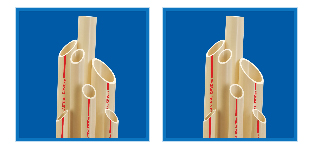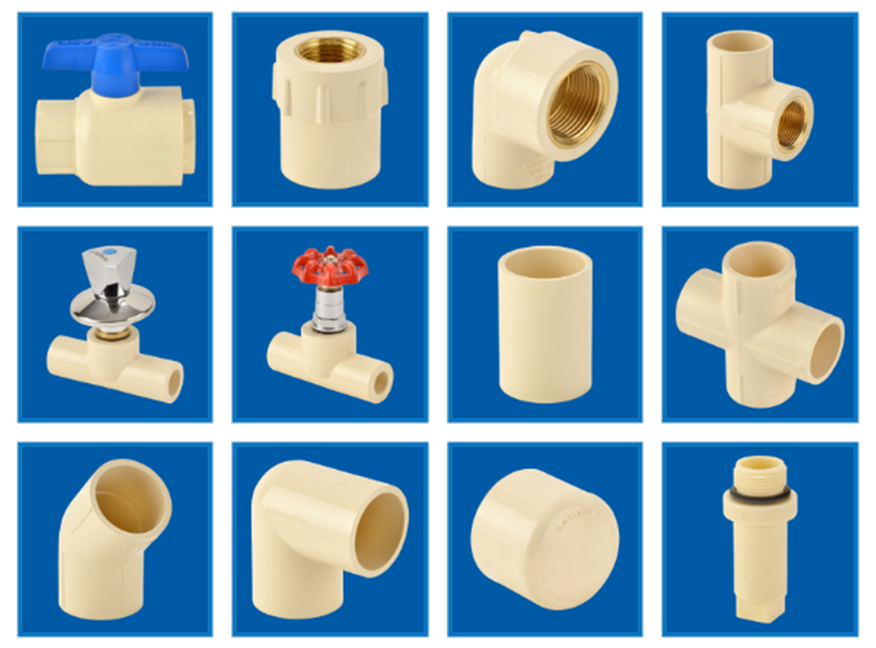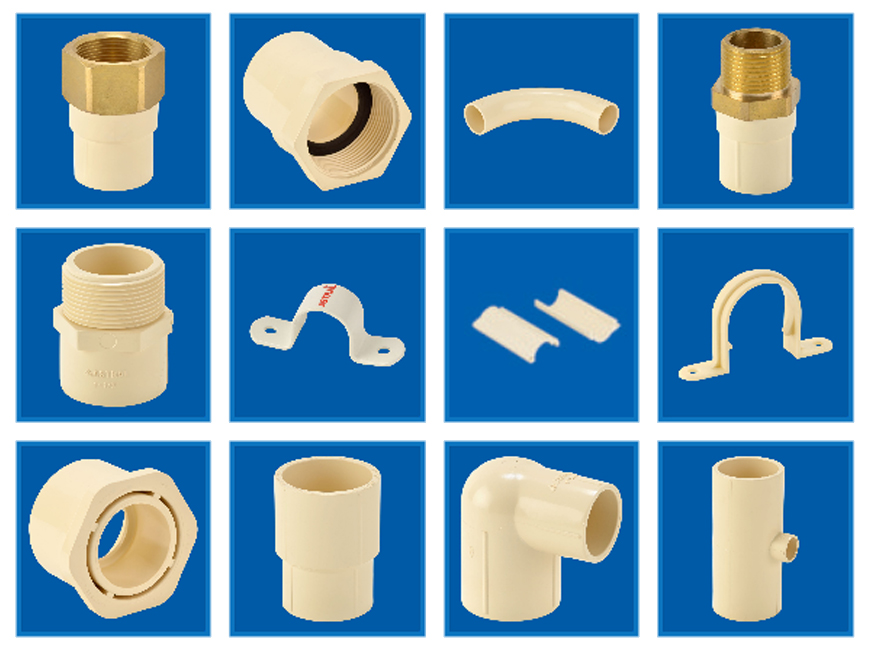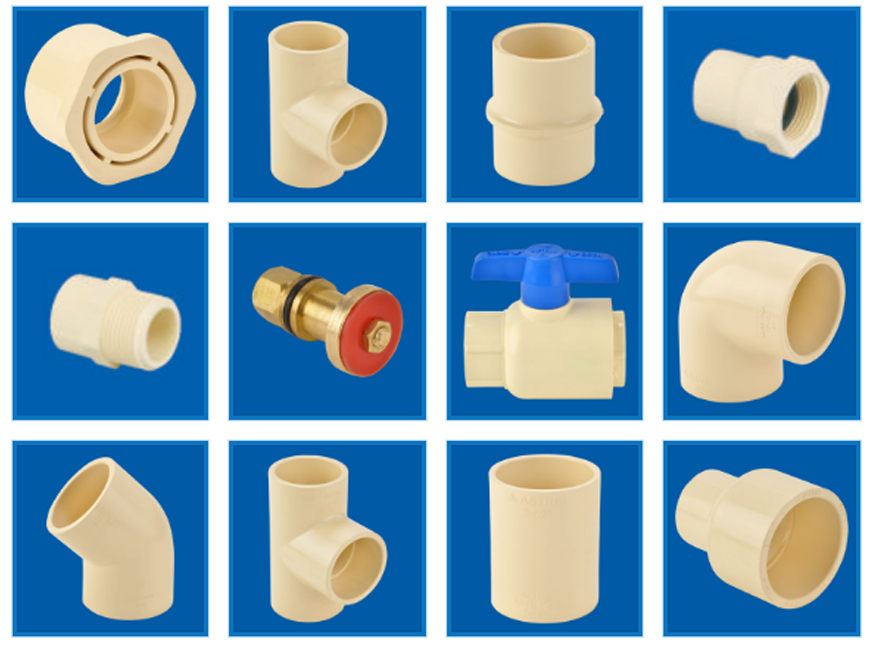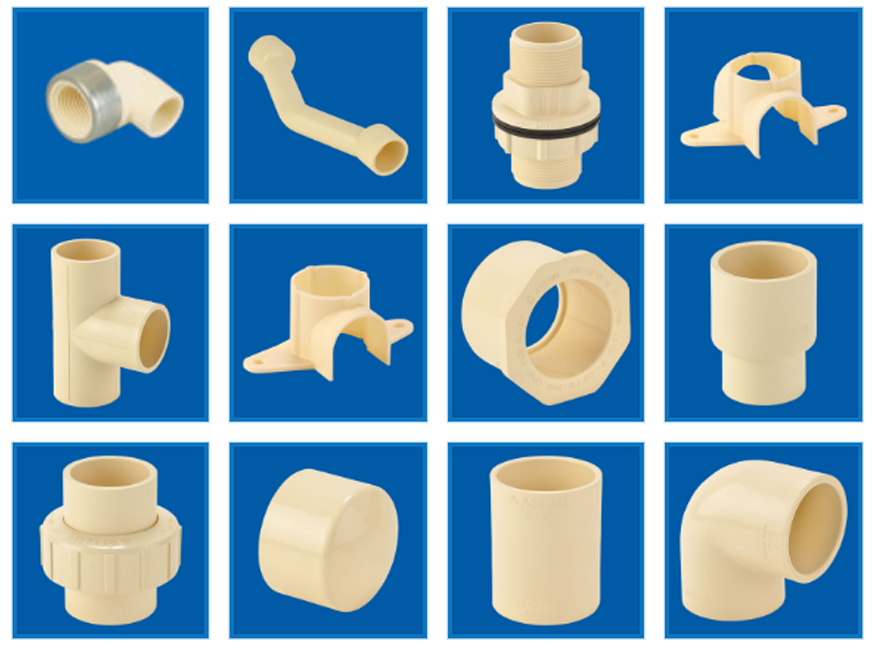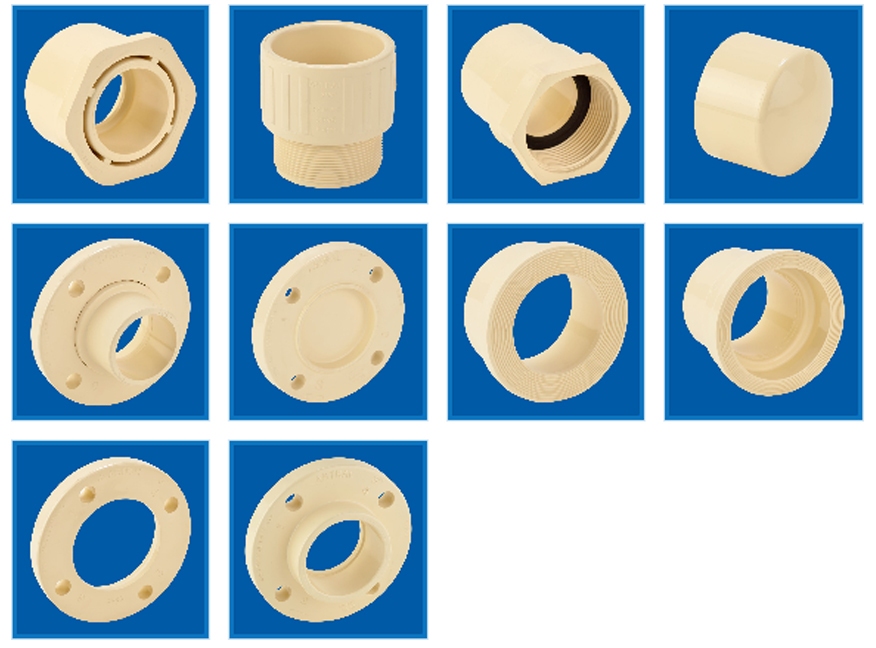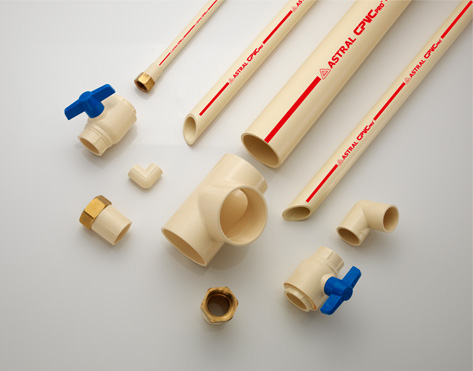
Astral CPVC Pro
Astral Poly Technik Limited is proud to introduce the all new advanced ASTRAL CPVC PRO. A class apart in the category, ASTRAL CPVC PRO is more than just a hot and cold plumbing system. To us it is an initiative, to deliver a world class plumbing solution.
ASTRAL CPVC PRO pipes and fittings, manufactured by Astral Poly Technik Ltd., are made from the specialty plastic, chemically known as Chlorinated Poly Vinyl Chloride (CPVC). This CPVC compound shall meet cell class DP 110-2-3-2 as per IS 15778 and a maximum service temperature up to 93°C. This compound is carefully designed in our R & D and backed by our own expertise of manufacturing CPVC piping system from last 17 years, which will give excellent results in all applications for CPVC piping system. It is unique combination of highest impact resistance without any loss in pressure bearing capacity / Tensile strength or Vicat softening temperature. This will ensure best trouble free service and also stood notch above the initial installation issues of cracking / damages due to handling, storage and installation.
These Pipes are produced in copper tube size (CTS) from 15 mm (½”) to 50 mm (2”) with two different standard dimensional ratios – SDR-11 and SDR-13.5 (Class 1 & Class 2 respectively as per IS 15778) . The fittings are produced as per SDR 11. The Pipes and Fittings in SDR 11 class is also complies to ASTM standard. All Astral CPVC SDR 11 and SDR 13.5 pipes are made from identical CPVC compound material having same physical properties. The CPVC fittings are manufactured from compound material which meets all the requirement as per ASTM standard.
Apart from having the same physical properties, SDR 11 and SDR 13.5 which are having different wall thickness and therefore, at any given temperature, they have different pressure ratings. For e.g.
PipeTemperature (°C)Pressure Rating
| Grade | Unit | 23°C | 82°C |
|---|---|---|---|
| SDR 11 | PSI | 400 | 100 |
| Kg/cm2 | 28.1 | 7.0 | |
| SDR 13.5 | PSI | 320 | 80 |
| Kg/cm2 | 22.5 | 5.6 |
Astral also produces CPVC PRO pipes in iron pipe size (IPS), available sizes are 65 mm (2½”) to 300 mm (12”) in SCH 40 and SCH 80 which meets the requirements of ASTM F 441. The pressure ratings varies with schedule pipe size and temperature. CPVC pipes of Copper Tube Size (CTS) dimensions can also be connected to CPVC (IPS) dimensions by using IPS x CTS fittings.
STANDARDS & SPECIFICATIONS :
IS 15778 : Standard Specification for CPVC pipes for Hot and Cold Water Supplies -Specification.
ASTM D1784 : Standard Specification for Rigid Poly (Vinyl Chloride) (PVC) Compounds and Chlorinated Poly (Vinyl Chloride) (CPVC) Compounds.
ASTM D2846 : Specification for Chlorinated Poly (Vinyl Chloride) (CPVC) Plastic Hot & Cold water distribution systems.
ASTM F493 : Standard Specification for Solvent Cements for Chlorinated Poly (Vinyl Chloride) (CPVC) Plastic Pipe & Fittings.
ASTM F441 : Standard Specification for Chlorinated Poly (Vinyl Chloride) (CPVC) Plastic Pipe, SCH 40 & 80.
ASTM F438 : Socket- Type Chlorinated Polyvinyl Chloride Plastic Pipe Fittings. Schedule 40.
ASTM F439 : Socket-Type Chlorinated Polyvinyl Chloride Plastic Pipe Fittings. Schedule 80.
ASTM D2774 : Underground installation of Thermoplastic pipes.
NSF CERTIFIED : NSF International, a not-for-profit, non-governmental organization is the world leader in standards development, product certification, education, and risk management for public health and safety (www.nsf.org). For 65 years, NSF has been committed to public health, safety and environmental protection. The NSF Mark is recognized for its value in international trade and is respected by regulatory agencies at the local, state, and national levels. Astral is the first Indian company to obtain certification from NSF for its CPVC products.
MARKING AND UNIFORMITY : Pipes and fittings made from CPVC compounds shall be clearly marked with the manufacturers trademark, material designation, applicable ASTM / IS standard.
SDR 11 Pipe : Tan coloured with red stripe SDR 11 fittings : Tan Colour
SDR 13.5 Pipe : Tan coloured with brown stripe SDR 11 fittings : Tan Colour
SCH 40 Pipe : Tan coloured with brown stripe SCH 40 fittings : Tan Colour
SCH 80 Pipe : Tan coloured red stripe SCH 80 fittings : Tan Colour/Grey Colour
FIELDS OF APPLICATIONS : Hot and Cold water applications in homes, apartments, hotels, resorts, hospitals, high and low rise buildings, corporate and commercial houses, academic institutes etc. for pure and hygienic water supply.
THERMAL EXPANSION AND THERMAL STRESSES
| Outside Diameters and Wall Thicknesses For CPVC 4120, SDR 11 Plastic Pipe As Per ASTM D-2846 | ||||||||
| Nominal Size
(in.) (mm) |
Outside Diameter, in. (mm) | Wall Thickness, in. (mm) | Pressure Ratting. PSI (Kg.Cm²) | |||||
| Avarage | Tolerance | Minimum | Tolerance | 73.4°F (23°C) | 180°F (82°C) | |||
| ½* (15) | 0.625 (15.9) | ± 0.003 (0.08) | 0.068 (1.73) | +0.020 (0.51) | 400 | (28.1) | 100 | (7.0) |
| ¾ (20) | 0.875 (22.2) | ± 0.003 (0.08) | 0.080 (2.03) | +0.020 (0.51) | 400 | (28.1) | 100 | (7.0) |
| 1 (25) | 1.125 (28.6) | ± 0.003 (0.08) | 0.102 (2.59) | +0.020 (0.51) | 400 | (28.1) | 100 | (7.0) |
| 1¼ (32) | 1.375 (34.9) | ± 0.003 (0.08) | 0.125 (3.18) | +0.020 (0.51) | 400 | (28.1) | 100 | (7.0) |
| 1½ (40) | 1.625 (41.3) | ± 0.004 (0.10) | 0.148 (3.76) | +0.020 (0.51) | 400 | (28.1) | 100 | (7.0) |
| 2 (50) | 2.125 (54.0) | ± 0.004 (0.10) | 0.193 (4.90) | +0.023 (0.58) | 400 | (28.1) | 100 | (7.0) |
* For ½” wall thickness minimum is not a function of SDR.
THERMAL EXPANSION AND CONTRACTION :
Like all piping material, Astral CPVC PRO expand when heated and contract when cooled. CPVC piping (regardless of pipe diameter) will expand about 1 inch per 50 feet of length when subjected to a 50° F temperature increase, therefore, allowances must be made for this resulting movement. However, laboratory testing and installation experience have demonstrated that the practical issues are much smaller than the coefficient of thermal expansion would suggest. The stresses developed in CPVC pipe are generally much smaller than those developed in metal pipe for equal temperature changes because of the difference in elastic modulus. Required loops are smaller than those recommended by the Copper Development Association for copper systems.
Expansion is mainly a concern in hot water lines, Generally, thermal expansion can be accommodated with changes in direction. However, a long straight run may require an offset or loop. Only one expansion loop, properly sized is required in any single straight run, regardless of its total length. If more convenient, two or more smaller expansion loops, properly sized, can be utilized in a single run of pipe to accommodate the thermal movement. Be sure to hang pipe with smooth straps that will not restrict movement. For convenience, loop (or offset) length have been calculated for different pipe sizes and different run length with a temperature increase (?T) of about 80°F. The results, shown in Tables A and B, are presented simply as a handy guide for quick and easy determinations of acceptable loop length for other temperatures and run length can be calculated utiliaing the following equations :
Where :
L = Loop length (in.)
E = Modulus of elasticity at maximum temperature (psi)
S = Working Stress at maximum temperature (psi)
D = Outside diameter of pipe (in.)
ΔL = Change in length due to change in temperature (in.)
Thermal Expansion Formula Where :
ΔL = Change in length due to change in temperature (in.)
Lp = Length of pipe (in.)
C = Coefficient of thermal expansion (in. / in. /°F)
= 3.4 x 10-5 in. / in./°F for CPVC
ΔT = Change in temperature (°F)
| Temperature °F (°C)
|
Modulus, E (psi) |
|
| Stress, S(psi) |
||
| 73 (27) | 423,000 | 2000 |
| 90 (32) | 403,000 | 1800 |
| 110 (43) | 371,000 | 1500 |
| 120 (49) | 355,000 | 1300 |
| 140 (60) | 323,000 | 1000 |
| 160 (71) | 291,000 | 750 |
| 180 (82) | 269,000 | 500 |
Calculated Loop (Offset) Length with ΔT of approx. 80°F in inches
| Nominal Pipe Sizemm in. |
Length of Run in Feet
Loop Length(L) in inches |
|||||||
| 15 ½ | 22 | 27 | 31 | 34 | ||||
| 20 ¾ | 26 | 32 | 36 | 41 | ||||
| 25 1 | 29 | 36 | 41 | 46 | ||||
| 32 ¼ | 32 | 40 | 46 | 51 | ||||
| 40 1½ | 35 | 43 | 50 | 56 | ||||
| 50 2 | 40 | 49 | 57 | 64 | ||||
Astral CPVC PRO IPS PIPES (ASTM F 441)
Calculated Loop (Offset) Length with ΔT of approx. 80°F in inches
| Nominal Pipe Size
mm in. |
Length of Run in feet
|
|||||||
| 65 2½ | 47 | 57 | 66 | 74 | ||||
| 75 3 | 52 | 63 | 73 | 82 | ||||
| 100 4 | 58 | 72 | 83 | 92 | ||||
| 150 6 | 71 | 87 | 100 | 112 | ||||
| 200 8 | 81 | 99 | 114 | 128 | ||||
| 250 10 | 90 | 111 | 128 | 143 | ||||
| 300 12 | 98 | 121 | 139 | 156 | ||||
HORIZONTAL AND VERTICAL SUPPORT :
Horizontal & Vertical runs of Astral CPVC PRO Pipe should be supported by pipe clamps or by hangers located on the horizontal connection close to the riser hangers should not have rought or sharp edges, which come in cotact with the pipe.
| SPACING | ||||
| Nominal Pipe Size | 21°C (70°F) | 49°C (120°F) | 71°C (160°F) | 82°C (180°F) |
| mm in. | Ft. (cm) | Ft. (cm) | Ft. (cm) | Ft. (cm) |
| 15 ½ | 5.5 (167.70) | 4.5 (137.16) | 3.0 (91.44) | 2.5 (76.20) |
| 20 ¾ | 5.5 (167.70) | 5.0 (152.40) | 3.0 (91.44) | 2.5 (76.20) |
| 25 1 | 6.0 (182.88) | 5.5 (167.70) | 3.5 (106.68) | 3.5 (91.44) |
| 32 1¼ | 6.5 (198.12) | 6.0 (182.88) | 3.5 (106.68) | 3.5 (106.68) |
| 40 1½ | 7.0 (213.36) | 6.0 (182.88) | 3.5 (106.68) | 3.5 (106.68) |
| 50 2 | 7.0 (213.36) | 6.5 (198.12) | 4.0 (121.92) | 3.5 (106.68) |
| 65 2½ | 8.0 (244.00) | 7.5 (228.60) | 4.5 (137.16) | 4.0 (121.92) |
| 75 3 | 8.0 (244.00) | 7.5 (228.60) | 4.5 (137.16) | 4.0 (121.92) |
| 100 4 | 9.0 (274.32) | 8.5 (259.08) | 5.0 (152.40) | 4.5 (137.16) |
| 150 6 | 10.0 (304.80) | 9.0 (274.32) | 5.5 (167.07) | 5.0 (152.40) |
| 200 8 | 11.0 (335.28) | 10.0 (304.80) | 6.0 (182.88) | 5.5 (167.07) |
TRANSITION FITTINGS & JOINTS :
Special transition fittings or joints are used whenever CPVC piping is connected to a metal valve, fittings, or other appurtenance such as a filter, or to parts made of another plastic. These special transition fittings can have many forms. One common form is the true union with a metal end and a CPVC end held together with a plastic or metal gland nut and having an elastomeric seal between them. Other forms are the flanged joint, the grooved joint, insert molded metal in CPVC fittings, patented push-on type fittings and finally the CPVC female threaded adapter with an elastomeric seal at the bottom of the thread. The later fittings are designed so that they have no thread interference and rely entirely on the elastomeric seal for water tightness. They require only minimal torque to attain an adequate seal.
Standard compression fittings which utilize brass of plastic ferrules can be used to assemble CPVC. However, Teflon® tape should be applied over the brass ferrule to compensate for the dissimilar thermal expansion rates of the brass and CPVC that could possibly otherwise result in a leak. Care should be taken not to over-torque the compression connection.
Metal fittings with CPVC socket inserts are also available. The tubing is cemented directly into the socket in the same way as an all-CPVC fittings.
The standard practice is to thread a male thread adapter into the female threaded part, such as a valve of stop, and then solvent cement to the CPVC pipe. However, when using the male thread adapter, there are two limitations that the installer must consider when deciding where and how to use it. First, the male thread adapter may develop a drip leak if the joint is subjected to too broad temperature range. And second, some thread sealants intended to minimize leak problems may chemically attack the CPVC and cause stress cracking of the adapter (see Thread Sealants section). The preferred method of transitioning between metal and CPVC plumbing component is to use an insert molded metal-in-CPVC fitting or true union with a metal and a CPVC end.
CPVC pipes and fittings can be installed underground. Since these piping systems are flexible systems, proper attention should be given to burial conditions. The stiffness of the piping system is affected by sidewall support, soil compaction, and the condition of the trench. Trench bottoms should be smooth and regular in either undisturbed soil or a layer of compacted backfill. Pipe must lie evenly on this surface throughout the entire length of its barrel. Excavation, bedding and backfill should be in accordance with the provision of the local Plumbing Code having jurisdiction.
TRENCHING :
The following trenching and burial procedures should be used to protect the piping system.
The trench should be excavated to ensure the sides will be stable under all working conditions.
The trench should be wide enough to provide adequate room for the following :
Joining the pipe in the trench.
Snaking the pipe from side or side to compensate for expansion and contraction.
Filling and compacting the side fills.
The space between the pipe and trench wall must be wider than the compaction equipment used in the compaction of the backfill. Minimum width shall not be less than the greater of either the pipe outside diameter plus 16 inches or the pipe outside diameter times 1.25 plus 12 inches. Trench width may be different if approved by the design engineer.
The trench bottom should be smooth, free of rocks and debris, continuous, and provide uniform support. If ledge rock, hardpan or large boulders are encountered, the trench bottom should be padded with bedding of compacted granular material to a thickness of at least 4 inches. Foundation bedding should be installed as required by the engineer.
Trench depth is determined by the pipe’s service requirements. Plastic pipe should always be installed at least below the frost level. The minimum cover for lines subject to heavy overhead traffic is 24 inches.
A smooth trench bottom is necessary to support the pipe over its entire length on firm stable material. Blocking should not be used to change pipe grade or to intermittently support pipe over low sections in the trench.
BEDDING AND BACKFILLING :
Even though sub-soil conditions vary widely from place to place, the pipe backfill should be stable and provide protection for the pipe.
The pipe should be surrounded with a granular material which is easily worked around the sides of the pipe Backfilling should be performed in layer of 6 inch with each layer being sufficiently compacted to 85% to 95% compaction.
A mechanical tamper is recommended for compacting sand and gravel backfill which contain a significant proportion of fine grained material, such as silt and clay. If a tamper is not available, compacting should be done by hand.
The trench should be completely filled. The backfill should be placed and spread in fairly uniform layers to prevent any unfilled spaces or voids. Large rocks, stones, frozen clods, or other large debris should be removed. Heavy tampers or rolling equipment should only be used to consolidate only the final backfill.
HANDLING :
The pipe should be handled with reasonable care. Because thermoplastic pipe is much lighter in weight than metal pipe, there is sometimes a tendency to throw it around. This should be avoided.
The pipe should never be dragged or pushed from a truck bed. Pallets for pipe should be removed with a fork lift. Loose pipe can be rolled down timbers as long as the pieces do not fall on each other or on any hard or uneven surface.
In all cases, severe contact with any sharp objects (rocks, angle irons, forks on forklifts, etc.) should be avoided.
STORING :
If possible, pipe should be stored inside. When this is not possible, the pipe should be stored on level ground which is dry and free from sharp objects. If different schedules of pipes are stacked together, the pipes with the thickest walls should be at the bottom.
The pipes should be protected from the sun and be in an area with proper ventilation. This will lessen the effects of ultraviolet rays and help prevent heat built-up.
If the pipes are stored in racks, it should be continuously supported along its length. If this is not possible, the spacing of the supports should not exceed three feet (3’).
When storage temperatures are below 0°C (32°F). extra care be taken when handing the pipe. This will help prevent any problems which could be caused by the slightly lower impact strength of PVC pipes at temperature below freezing.
Hot and Cold water compatible :
Astral CPVC PRO Piping System is compatible with both hot and cold water. It withstand very high temperature compared to any other thermoplastic plumbing systems. Many solar and electric water heaters have CPVC piping system for heat efficiency and lower installation cost.
Corrosion resistance :
Astral CPVC PRO Piping System gives excellent resistance even under the harshest of water conditions so there are none of the purity worries from corrosion of metal pipe or soldered joints. Astral CPVC PRO Piping System keeps pure water pure.
Lower bacterial growth :
Bacteria build up with CPVC is far lower than with alternative piping materials – Copper, Steel and other thermoplastics.
Tough, rigid material :
Astral CPVC PRO Piping System has a much higher strength than other thermoplastics used in plumbing. This means that CPVC needs less hangers and supports and there is no unsightly looping of the pipe. Astral CPVC PRO Piping System has a higher pressure bearing capability. This leads to the same flow rate with a smaller pipe size.
No Scale, pit or leach formation :
Even after years of use in the most aggressive conditions, Astral CPVC PRO Piping System won’t corrode, standing up to low pH water, coastal salt air exposures and corrosive soils. Astral CPVC PRO Piping System stays as solid and reliable as the day it was installed. It maintains full water carrying capacity because its scale resistance means no build up to cause water pressure loss.
Unaffected by chlorine in the water :
Some materials may be adversely affected by chlorine contained in the water supply, which can cause breakdown of the polymer chains and potential leaks. In this respect, Astral CPVC PRO Piping System is unaffected by the chlorine present in potable water supply.
Chemical resistance :
CPVC has excellent chemical resistance to strong mineral acids and bases.
Low thermal expansion :
Astral CPVC PRO Piping System has a lower coefficient of thermal expansion than alternative plastics, reducing the amount that the pipe expands when hot water is running, again reducing unsightly ‘looping’ of the pipe.
Easy, cold welding process :
CPVC uses a simple, solvent cement jointing method. Tools required are very simple and inexpensive (chamfering tool and pipe cutter only) and avoid the need for an electrical source.
Superior insulation :
Astral CPVC PRO Piping System is more energy efficient than metal pipe. As an insulator it does not lose heat the way metal pipe do. Heat loss and thermal expansion are reduced.
Fire safety :
CPVC has a limiting Oxygen Index (LOI) of 60. Thus in air, Astral CPVC PRO Piping System does not support combustion. No flaming drips, does not increase the fire load, low flame spread, low smoke generation.
Cost effective :
CPVC Plumbing System is very cost effective than any other plumbing systems. It saves cost on fittings, loops, anchors, offsets, insulation, labour and expensive tools. More over CPVC plumbing systems last longer more than 50 years.

